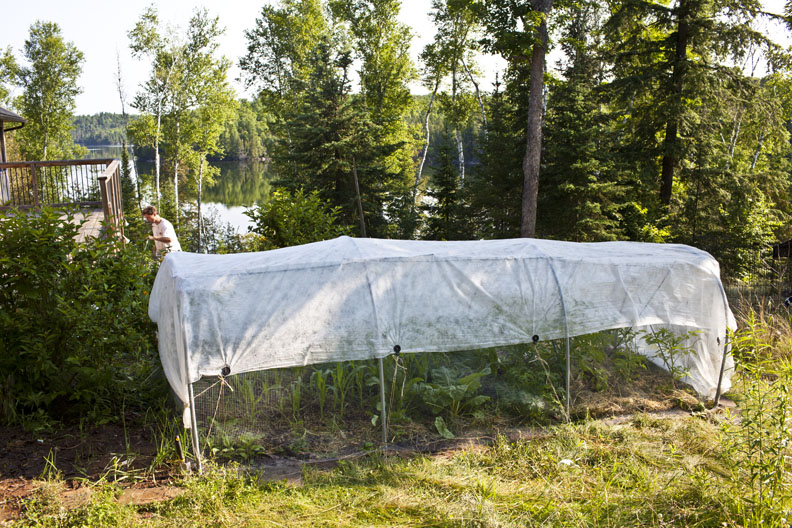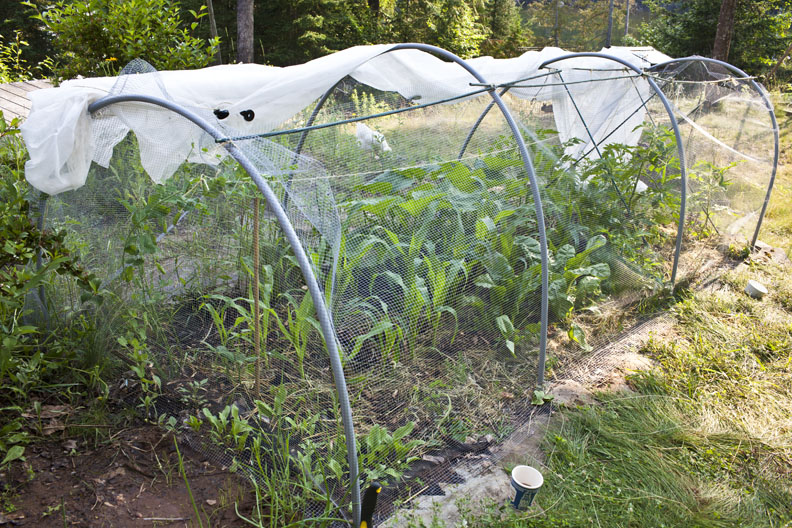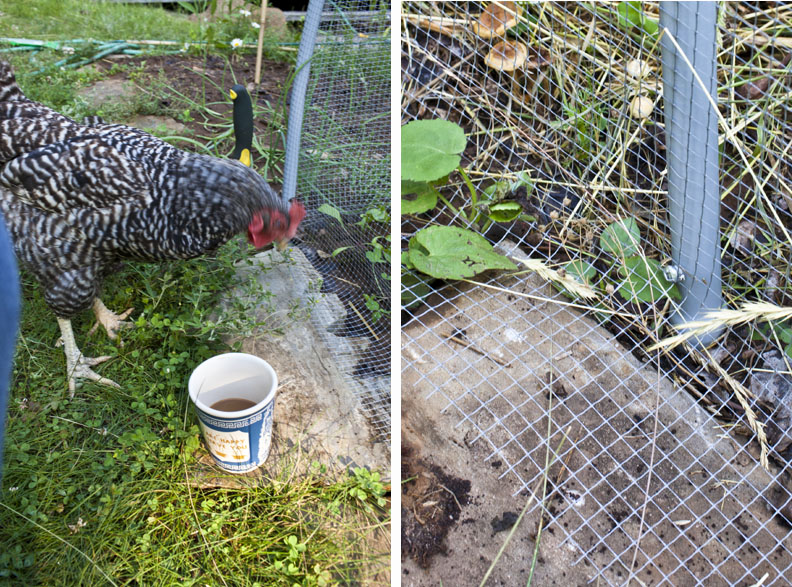This is what happens when you start working on a post and then you get busy, then you go to the cottage, then you get busy. It’s a long one, with a mish mash of stuff, so go grab yourself a nice cold drink and visit for a while.
I wanted to grow herbs and vegetables at the cottage, but didn’t want the maintenance. After reading Patricia Lanza’s story on Lasagna Gardening, I was inspired to start compiling newspapers and cardboard. Is it really possible to have a garden that requires no tilling or digging, little watering, and virtually no weeding? All I have to say is YES.
We started the lasagna bed this past fall at the cottage, so that it could “cook” and compost over the winter. Late May, we planted seeds and seedlings, covered it up, and left. After 4 weeks, we returned to find a thriving and lush vegetable garden. My city garden, the one that I water and tend to, isn’t doing nearly as well.


Deer, elk, raccoon, rabbits and chickens will come and nibble, so an inexpensive hoop house frame was built and wrapped with plastic chicken wire. Yes, animals could chew through it, but so far it’s been fine. The plastic netting is much easier to work with than metal wire. The top of the hoop house frame is then covered with a floating row cover from Lee Valley. The row cover is great as it allows water and light in, while diffusing the harsh sun. It’s also a visible barrier for wandering deer and elk.


At 4 weeks – peas, snow peas, french beans, summer squash, beets, corn, carrots, red onions, swiss chard, lettuce, spinach, herbs, and tomatoes.


Rebar (3/8″ diameter x 2′ long) is stuck in the ground, and PVC pipe (3/4″ diameter x 10′ long) is bent and placed overtop the rebar. All of this is not very expensive, can be installed in a matter of minutes without tools, and available at any building store. In the fall, you can cover it in plastic to make a coldhouse, extending the growing season. I’m a huge fan of Eliot Coleman, who’s book, “The Winter Harvest Handbook: Year Round Vegetable Production Using Deep Organic Techniques and Unheated Greenhouses”, tells you how to grow cold hardy greens like chard, spinach, lettuce and bok choy in winter.


Short screws are drilled halfway into the pipe to hold the netting in place top and bottom. The bottom has extra netting to make a skirt to keep animals from digging in. We got our netting at Canadian Tire, it comes in convenient rolls of 2, 3, and 4 foot widths. The screws are also great for tying supports and the row cover to.


When you want access to the garden, simply unhook top or bottom and peel back the netting. I also have this same set up in the city to keep out squirrels, racoons and marauding chickens. Look at this swiss chard, it’s giant compared to the one in the city garden.


At 6 weeks – we’ve had only one trickle of rainfall, and it’s been HOT. No one seemed to suffer except some wilted chard, but they bounced back after a watering.


I love that we can have fresh produce out here in the middle of nowhere. Just walk into the garden and see what’s for dinner.


A handful of freshly harvested peas and swiss chard ended up sautéed in olive oil with anchovies and garlic, then tossed with penne and parmesan cheese. My three kids gobbled it up, which makes me happy.


Summer salad sprinkled with edible petals & blossoms. I didn’t grow this, but it’s darn pretty isn’t it? Next year I want to grow edible flowers and a field of tomatoes for sauce production.


An A-frame chicken tractor that hubby built from scrap lumber around the cottage. We move it around so the girls can cut the grass, eat the ants, and fertilize. At night, it’s lock-down in the insulated “oven”.


The girls also free-range around, it’s amazing how they know to stick close to home and come in at night.


Piper, the black & white rex bunnie has escaped in the city. If anyone sees her, please let me know. Emily, the dwarf brown one escaped this past weekend at the cottage…four times! Having experienced freedom and wild bunnies, she refuses to be caged. Be free baby girl, and be careful.


Okay, back to work and lasagna gardening before this becomes the world’s longest post. There is a fabulous camp on our lake, where there is horses…and an endless supply of manure which we are welcome to. Thank you Peter.


Unloading the composted manure for a second lasagna bed. Nothing beats shovelling manure on a hot summer day.




To make a lasagna garden, you start with a few layers of newspaper or cardboard to block out weeds and draw earthworms to the area. We ran out of newspaper, but found a few of the kids’ colouring pads.


Next, add a layer of manure or compost. Then, you alternate layers of green organic material (nitrogen rich like grass clippings, green kitchen waste, green garden trimmings), and brown organic matter (carbon rich, like fall leaves, peat moss, straw, newspaper).


Repeat all these layers, including paper, till at least 18″ high, the pile will compost down over time.


Be sure to water and soak each layer. If you want to plant right away, be sure to add more compost and peat. Just break through the layers with a shovel, and insert seed or seedlings in between. I plan to plant a bed garlic here in the fall.




Peace…


…and quiet.


Maggie | Eat Boutique - I would like a lasagna bed. I just need a camp to build it by. :p My husband loves when I read your site, he gets all sorts of projects added to his list. 🙂
Deirdre Pickford - ive said it before and ill say it again…you are one amazing and inspirational gal jill chen!!!
Julia - First time I’ve seen a chicken in a boat. Maybe a first for the chicken as well?